Valerenic acid

Valerenic acid structure
|
Common Name | Valerenic acid | ||
|---|---|---|---|---|
| CAS Number | 3569-10-6 | Molecular Weight | 234.334 | |
| Density | 1.1±0.1 g/cm3 | Boiling Point | 374.5±21.0 °C at 760 mmHg | |
| Molecular Formula | C15H22O2 | Melting Point | 134-139ºC | |
| MSDS | Chinese USA | Flash Point | 274.2±13.0 °C | |
Use of Valerenic acidValerenic acid ((-)-Valerenic Acid), a sesquiterpenoid, is an orally active positive allosteric modulator of GABAA receptors. Valerenic acid is also a partial agonist of the 5-HT5a receptor. Valerenic acid mediates anxiolytic activity via GABAA receptors containing the β3 subunit. Valerenic acid also exhibits potent antioxidant properties[1][2][3]. |
| Name | valerenic acid |
|---|---|
| Synonym | More Synonyms |
| Description | Valerenic acid ((-)-Valerenic Acid), a sesquiterpenoid, is an orally active positive allosteric modulator of GABAA receptors. Valerenic acid is also a partial agonist of the 5-HT5a receptor. Valerenic acid mediates anxiolytic activity via GABAA receptors containing the β3 subunit. Valerenic acid also exhibits potent antioxidant properties[1][2][3]. |
|---|---|
| Related Catalog | |
| Target |
5-HT5A Receptor:17.2 μM (IC50) GABAA |
| In Vitro | Valerenic acid (1-100 μM) enhances the whole cell currents on GABAA receptors expressed in HEK 293 cells[1]. Valerenic acid exhibits significant affinity for the 5-HT5a receptor, with an IC50 of 17.2 μM (Ki=10.7 μM)[2]. [3H]Valerenic acid binds to brain membranes reveals both a high affinity binding site (KD=25 nM) and a low affinity site (KD=16 μM)[1]. [3H]Valerenic acid is displaced by Valerenol with high potency (IC50=3 nM)[1]. |
| In Vivo | Valerenic acid (1-6 mg/kg i.p. or 10 mg/kg p.o.) decreases the aversion of wild type mice to the lit area[2]. Valerenic acid (10 mg/kg; p.o.) increases the proportion of time 129X1/SvJ mice spent onto the open arms[2]. |
| References |
| Density | 1.1±0.1 g/cm3 |
|---|---|
| Boiling Point | 374.5±21.0 °C at 760 mmHg |
| Melting Point | 134-139ºC |
| Molecular Formula | C15H22O2 |
| Molecular Weight | 234.334 |
| Flash Point | 274.2±13.0 °C |
| Exact Mass | 234.161987 |
| PSA | 37.30000 |
| LogP | 5.13 |
| Vapour Pressure | 0.0±1.8 mmHg at 25°C |
| Index of Refraction | 1.529 |
| Storage condition | −20°C |
|
SECTION 1: Identification of the substance/mixture and of the company/undertaking Product identifiers Product name: Valerenic acid REACH No.: A registration number is not available for this substance as the substance or its uses are exempted from registration, the annual tonnage does not require a registration or the registration is envisaged for a later registration deadline.
CAS-No.: 3569-10-6 Relevant identified uses of the substance or mixture and uses advised against Identified uses: Laboratory chemicals, Manufacture of substances SECTION 2: Hazards identification Classification of the substance or mixture Not a hazardous substance or mixture according to Regulation (EC) No 1272/2008 This substance is not classified as dangerous according to Directive 67/548/EEC. Label elements Other hazards - none SECTION 3: Composition/information on ingredients Substances Formula: C15H22O2 Molecular Weight: 234,33 g/mol CAS-No.: 3569-10-6 No components need to be disclosed according to the applicable regulations. SECTION 4: First aid measures Description of first aid measures If inhaled If breathed in, move person into fresh air. If not breathing, give artificial respiration. In case of skin contact Wash off with soap and plenty of water. In case of eye contact Flush eyes with water as a precaution. If swallowed Never give anything by mouth to an unconscious person. Rinse mouth with water. Most important symptoms and effects, both acute and delayed The most important known symptoms and effects are described in the labelling (see section 2.2) and/or in section 11 Indication of any immediate medical attention and special treatment needed no data available SECTION 5: Firefighting measures Extinguishing media Suitable extinguishing media Use water spray, alcohol-resistant foam, dry chemical or carbon dioxide. Special hazards arising from the substance or mixture Carbon oxides Advice for firefighters Wear self contained breathing apparatus for fire fighting if necessary. Further information no data available SECTION 6: Accidental release measures Personal precautions, protective equipment and emergency procedures Avoid dust formation. Avoid breathing vapours, mist or gas. For personal protection see section 8. Environmental precautions Do not let product enter drains. Methods and materials for containment and cleaning up Sweep up and shovel. Keep in suitable, closed containers for disposal. Reference to other sections For disposal see section 13. SECTION 7: Handling and storage Precautions for safe handling Provide appropriate exhaust ventilation at places where dust is formed. For precautions see section 2.2. Conditions for safe storage, including any incompatibilities Store in cool place. Keep container tightly closed in a dry and well-ventilated place. Light sensitive. Store under inert gas. Specific end use(s) Apart from the uses mentioned in section 1.2 no other specific uses are stipulated SECTION 8: Exposure controls/personal protection Control parameters Components with workplace control parameters Exposure controls Appropriate engineering controls General industrial hygiene practice. Personal protective equipment Eye/face protection Use equipment for eye protection tested and approved under appropriate government standards such as NIOSH (US) or EN 166(EU). Skin protection The selected protective gloves have to satisfy the specifications of EU Directive 89/686/EEC and the standard EN 374 derived from it. Handle with gloves. Gloves must be inspected prior to use. Use proper glove removal technique (without touching glove's outer surface) to avoid skin contact with this product. Dispose of contaminated gloves after use in accordance with applicable laws and good laboratory practices. Wash and dry hands. Body Protection Choose body protection in relation to its type, to the concentration and amount of dangerous substances, and to the specific work-place., The type of protective equipment must be selected according to the concentration and amount of the dangerous substance at the specific workplace. Respiratory protection Respiratory protection is not required. Where protection from nuisance levels of dusts are desired, use type N95 (US) or type P1 (EN 143) dust masks. Use respirators and components tested and approved under appropriate government standards such as NIOSH (US) or CEN (EU). Control of environmental exposure Do not let product enter drains. SECTION 9: Physical and chemical properties Information on basic physical and chemical properties a) AppearanceForm: crystalline Colour: white b) Odourno data available c) Odour Thresholdno data available d) pHno data available e) Melting point/freezingno data available point f) Initial boiling point and no data available boiling range g) Flash pointno data available h) Evapouration rateno data available i) Flammability (solid, gas) no data available j) Upper/lowerno data available flammability or explosive limits k) Vapour pressureno data available l) Vapour densityno data available m) Relative densityno data available n) Water solubilityno data available o) Partition coefficient: n- no data available octanol/water p) Auto-ignitionno data available temperature q) Decompositionno data available temperature r) Viscosityno data available s) Explosive propertiesno data available t) Oxidizing propertiesno data available Other safety information no data available SECTION 10: Stability and reactivity Reactivity no data available Chemical stability Stable under recommended storage conditions. Possibility of hazardous reactions no data available Conditions to avoid no data available Incompatible materials Strong oxidizing agents Hazardous decomposition products Other decomposition products - no data available In the event of fire: see section 5 SECTION 11: Toxicological information Information on toxicological effects Acute toxicity no data available Skin corrosion/irritation no data available Serious eye damage/eye irritation no data available Respiratory or skin sensitisation no data available Germ cell mutagenicity no data available Carcinogenicity IARC:No component of this product present at levels greater than or equal to 0.1% is identified as probable, possible or confirmed human carcinogen by IARC. Reproductive toxicity no data available Specific target organ toxicity - single exposure no data available Specific target organ toxicity - repeated exposure no data available Aspiration hazard no data available Additional Information RTECS: Not available SECTION 12: Ecological information Toxicity no data available Persistence and degradability no data available Bioaccumulative potential no data available Mobility in soil no data available Results of PBT and vPvB assessment PBT/vPvB assessment not available as chemical safety assessment not required/not conducted Other adverse effects no data available SECTION 13: Disposal considerations Waste treatment methods Product Offer surplus and non-recyclable solutions to a licensed disposal company. Contaminated packaging Dispose of as unused product. SECTION 14: Transport information UN number ADR/RID: -IMDG: -IATA: - UN proper shipping name ADR/RID: Not dangerous goods IMDG: Not dangerous goods IATA:Not dangerous goods Transport hazard class(es) ADR/RID: -IMDG: -IATA: - Packaging group ADR/RID: -IMDG: -IATA: - Environmental hazards ADR/RID: noIMDG Marine pollutant: noIATA: no Special precautions for user no data available SECTION 15: Regulatory information This safety datasheet complies with the requirements of Regulation (EC) No. 1907/2006. Safety, health and environmental regulations/legislation specific for the substance or mixture no data available Chemical Safety Assessment For this product a chemical safety assessment was not carried out SECTION 16: Other information Further information Copyright 2014 Co. LLC. License granted to make unlimited paper copies for internal use only. The above information is believed to be correct but does not purport to be all inclusive and shall be used only as a guide. The information in this document is based on the present state of our knowledge and is applicable to the product with regard to appropriate safety precautions. It does not represent any guarantee of the properties of the product. Corporation and its Affiliates shall not be held liable for any damage resulting from handling or from contact with the above product. See and/or the reverse side of invoice or packing slip for additional terms and conditions of sale. |
| Personal Protective Equipment | Eyeshields;Gloves;type N95 (US);type P1 (EN143) respirator filter |
|---|---|
| RIDADR | NONH for all modes of transport |
| WGK Germany | 3 |
| Precursor 9 | |
|---|---|
| DownStream 0 | |
|
Concise synthesis of Valerena-4,7(11)-diene, a highly active sedative, from valerenic acid.
Biosci. Biotechnol. Biochem. 74(9) , 1963-4, (2010) A concise synthesis of valerena-4,7(11)-diene with potent sedative activity was achieved in three steps involving, reduction of carboxylic acid, bromination of the resulting alcohol, and reduction of ... |
|
|
Root colonization by symbiotic arbuscular mycorrhizal fungi increases sesquiterpenic acid concentrations in Valeriana officinalis L.
Planta Med. 76(4) , 393-8, (2010) In some medicinal plants a specific plant-fungus association, known as arbuscular mycorrhizal (AM) symbiosis, increases the levels of secondary plant metabolites and/or plant growth. In this study, th... |
|
|
Valerian extract and valerenic acid are partial agonists of the 5-HT5a receptor in vitro.
Brain Res. Mol. Brain Res. 138(2) , 191-7, (2005) Insomnia is the most frequently encountered sleep complaint worldwide. While many prescription drugs are used to treat insomnia, extracts of valerian (Valeriana officinalis L., Valerianaceae) are also... |
| 2-Propenoic acid, 3-[(4S,7R,7aR)-2,4,5,6,7,7a-hexahydro-3,7-dimethyl-1H-inden-4-yl]-2-methyl-, (2E)- |
| MFCD00075694 |
| (2E)-3-[(4S,7R,7aR)-3,7-Dimethyl-2,4,5,6,7,7a-hexahydro-1H-inden-4-yl]-2-methylacrylic acid |
| 7-Hydroxy-PIPAT maleate |
| (2E)-3-[(4S,7R,7aR)-3,7-dimethyl-2,4,5,6,7,7a-hexahydro-1H-inden-4-yl]-2-methylprop-2-enoic acid |
| Valerenic acid |
| Valerenic acid,(2E)-3-[(4S,7R,7aR)-2,4,5,6,7,7a-Hexadydro-3,7-dimethyl-1H-inden-4-yl]-2-methyl-2-propenoicacid |
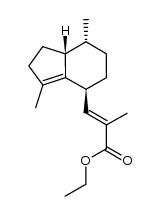 CAS#:1123095-70-4
CAS#:1123095-70-4 CAS#:4176-16-3
CAS#:4176-16-3 CAS#:930-30-3
CAS#:930-30-3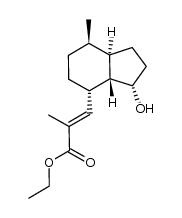 CAS#:1123095-65-7
CAS#:1123095-65-7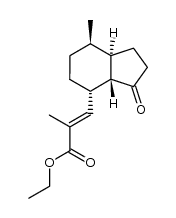 CAS#:1123095-67-9
CAS#:1123095-67-9![(2aR,7aS,7bR)-5-methyl-3,4,6,7,7a,7b-hexahydro-2aH-indeno[1,7-bc]furan-2-one Structure](https://image.chemsrc.com/caspic/165/1123095-60-2.png) CAS#:1123095-60-2
CAS#:1123095-60-2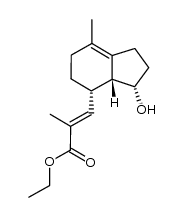 CAS#:1123095-63-5
CAS#:1123095-63-5 CAS#:1235967-22-2
CAS#:1235967-22-2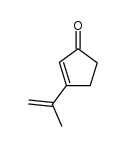 CAS#:108264-49-9
CAS#:108264-49-9
